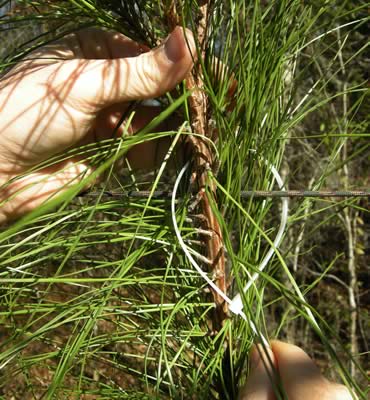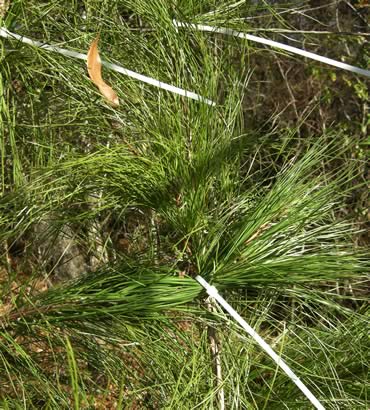Sometimes you can’t beat what nature provides.
Bowhunters are using ground blinds more often these days for several reasons: Some of the more senior bowhunters are less willing to climb trees because of the danger factor, and many others are simply afraid of heights. There are so many excellent commercial ground blinds on the market today that climbing trees is not the only option for whitetail hunters. Also, ground blinds are the perfect answer in areas where there are no adequate trees in which to place a treestand.
If you want to hunt from ground blinds, you have two options: buy one or build one. I’ve been successful using both, but I get particular pleasure when hunting from a ground blind I have made with my own hands. It just adds a more personal element to the hunting experience.
Today, no matter where I travel to hunt, I go prepared to make a ground blind if I need one. I have found a very simply and effective way of making one for very little money and with very few tools. Here’s the sum total of what you’ll need: a limb saw, a pair of branch clippers, 50 feet of nylon rope (something like parachute cord available at any outdoor or surplus store) and a package of nylon cable ties. The whole kit will fit in your fanny pack with room to spare.
The first thing to do is establish the perfect spot for your blind. When possible, utilize standing structure like trees, bushes, fence posts and the like. You’re always better off to build a blind around an existing structure of some type so that it doesn’t stick out like a sore thumb and alert deer to something new in their world.
For example, if there are several trees or bushes in close proximity to one another such that their trunks form a triangle, square or rectangle, you’re in business.
Establish the area that will be the floor of the blind and clear it of all debris, weeds, dead leaves, etc. When you make your blind you want the floor to be soft, bare dirt so your feet make absolutely no noise.
 Once the ground in clean, tie one end of your nylon rope to one of the trees or bushes at head height and string the rope tightly from tree to tree, securing the rope to each tree so that it can’t slip or loosen. Once the rope is in place, you’re ready to start cutting branches to create the walls of the blind. Cut them long enough to allow the butt ends to stand on the ground with enough height to attach their tops tightly to the nylon rope with your cable ties. This keeps the shrubbery standing in place. As you add more shrubbery, you can slide them together on the nylon rope to tighten the density of your walls. The walls should be dense enough to hide you from the deer but still allow you to see out between leaves and branches.
Once the ground in clean, tie one end of your nylon rope to one of the trees or bushes at head height and string the rope tightly from tree to tree, securing the rope to each tree so that it can’t slip or loosen. Once the rope is in place, you’re ready to start cutting branches to create the walls of the blind. Cut them long enough to allow the butt ends to stand on the ground with enough height to attach their tops tightly to the nylon rope with your cable ties. This keeps the shrubbery standing in place. As you add more shrubbery, you can slide them together on the nylon rope to tighten the density of your walls. The walls should be dense enough to hide you from the deer but still allow you to see out between leaves and branches.
You’ll have to determine where you want your shooting window. I’ve found that round or square shooting windows are inferior to a vertical slot-shaped window. The slot can be as much as two feet high, but the key is the width; 6 inches is plenty. The narrower the slot, the less visible your movement will be when you line up to shoot. You’ll be surprised how much area you can cover with a 6-inch-wide shooting window. If the animal is directly in front of your blind, he’s in an ideal position. However, I actually prefer the animal to be on either side of the slot rather than in front of it. That way I can aim and shoot without having to step directly in front of the opening.
Obviously, ground blinds that utilize natural shrubbery are subject to drying up and dropping leaves. For this reason, they’re a better bet early in the season when most bowhunters are afield. However, if you’re hunting in areas where evergreens grow and you make use of them, your blind will last longer.
 Most hunters who get picked off in ground blinds do so when moving to make a shot. I like a blind to be large enough for me to draw my bow before stepping into the shooting slot. That way I hide the movement of drawing the bow. All I have to do is ease into position and release my arrow.
Most hunters who get picked off in ground blinds do so when moving to make a shot. I like a blind to be large enough for me to draw my bow before stepping into the shooting slot. That way I hide the movement of drawing the bow. All I have to do is ease into position and release my arrow.
For extra security, I also suggest using bolts of inexpensive camo burlap like those found in the hunting department of most Wal-Mart stores. I use cable ties to spread the burlap on the inside of the blind on either side of the shooting slot, giving me even cover near the point of necessary movement.
Naturally, as with hunting whitetails from tree or ground, you must keep the wind in mind. You can forget the wind if you want to, but as soon as you do you’re no longer hunting; you’re just goofing around in the woods. Use every effort to suppress scent. In ground-blind hunting, scent management is critical. Always attempt to set your blind in a position downwind of where you expect to see deer.
I learned a most interesting trick from South African professional hunter Johan Schoonbee while bowhunting from a ground blind near a water hole in the bushveld of South Africa. Johan noted that the wind was wrong for the blind we wanted to hunt but he said he would bring his secret weapon, which turned out to be a small bottle of diesel fuel. He unscrewed the cap of the bottle slightly to allow the smell to escape and placed it at the downwind corner of the blind. Amazingly, every animal that came to that waterhole worked their way downwind of the blind to test the wind. They became very alert when they smelled the diesel fuel but calmed down quickly and went on about their business of getting a drink. It cost a fine waterbuck its life. I was amazed, because the diesel fuel certainly overpowered our human smell, and while the animals obviously smelled it, they were not afraid of it. Keep that in mind the next time the wind is wrong for your blind.
I am a big believer in the advantage of time. We all know that whitetails take exception to unexpected surprises, and ground blinds are no exception. Whenever possible, build your blind well in advance of your hunt. Allow it to become just another part of then scenery. Deer will adapt to it quickly enough.
Read Recent Articles: • All About Luck: Success isn’t always measured by animals on the ground.
• Foodplotting With an ATV: You don’t need a giant tractor to have a successful food plot.
• The Crossbow Effect: Are they good or bad for the sport of hunting?
This article was published in the July 2009 edition of Buckmasters Whitetail Magazine. Subscribe today to have Buckmasters delivered to your home.